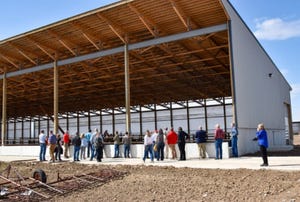Consider LRP Insurance For Feeder Cattle
The cattle market has seen an increase in price volatility in recent years, and this increased volatility translates into greater risk and uncertainty for cattle producers. For a risk-seeking individual, more volatility means a possibility of receiving higher returns on his cattle.
July 15, 2010

The cattle market has seen an increase in price volatility in recent years, and this increased volatility translates into greater risk and uncertainty for cattle producers. For a risk-seeking individual, more volatility means a possibility of receiving higher returns on his cattle. However, for risk-adverse individuals, increased volatility is something to be avoided if at all possible, says Dillon M. Feuz, Utah State University (USU) economist .
He points out that Caleb Bott, a USU graduate student, recently completed an analysis of how effective Livestock Risk Protection (LRP) insurance was for cattle producers.
Bott simulated returns for a thousand iterations to see how often the insurance paid out and to determine if most producers would prefer the insurance or would prefer to remain in the cash market. The simulation was based on observed prices for the past 20 years to understand the volatility in the market place. LRP premiums were tracked since the inception of the insurance product. To try and make the simulation as real as possible, not only were cattle prices varied but feed costs were also varied in the analysis.
Feuz calls the results of Bott’s analysis “very interesting.”
“He found that, on average, returns to a backgrounding-type program were reduced by $6.50/head if producers consistently purchased LRP insurance. When the market price was equal or higher than anticipated, returns were reduced about $13/head, the price of the insurance. However when prices were lower, returns had the potential of being much higher with the insurance. In some of the worst price wrecks, returns with insurance were more than $150/head higher than if the producer had remained strictly in the cash market,” Feuz says.
So, he adds, the decision each producer faces is whether they prefer a slightly lower return on average so that they can avoid the large losses, or a higher average return and know that some years will be very profitable and some years they will incur large losses.
“It’s likely that each producer will evaluate this decision a little differently. If you have a higher debt load on your operation, you may not be able to tolerate large losses and therefore the insurance may look better to you. Conversely, a producer who has sufficient equity may prefer to take the good and the bad in the market and know that in the long run they will make more money without the insurance. The one thing that we would all like to do, but which I am doubtful any of us can do, is to only insure in years when price will decline and not insure when price will be stable or higher,” Feuz says.
Economists and insurers have tried to group people into categories such as risk-averse, risk-neutral and risk-preferring. Feuz says most people tend to fall in the risk-averse category, but even this category is really a continuum from slightly risk averse to highly risk averse.
“Bott also did an analysis to determine the types of producers who may prefer the insurance. He found that those cattle producers who were risk-preferring or risk-neutral definitely wouldn’t purchase the insurance. He also found that producers who were only slightly risk-averse probably would also not purchase the insurance. However, he found that as a producers risk aversion moved to moderate or highly risk averse, they would prefer to buy LRP insurance. Prior studies of ag producers have found that most are in the slight-to-moderate, risk-averse category,” Feuz says.
For more info on LRP insurance, visit livestockinsurance.unl.edu/ or www.rma.usda.gov/livestock/.
-- Dillon M. Feuz, Utah State University
You May Also Like


.png?width=300&auto=webp&quality=80&disable=upscale)
